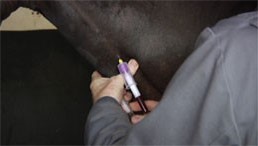Poor Performance

Poor Performance in Horses.
Firstly, it is important to establish the details of the problems to determine if there is a true poor performance issue. If the horse fails to get to the levels of performance already achieved, with no apparent reason, poor performance can be suggested.
An open-minded evaluation is vital to direct the investigation towards the main cause or causes of poor performance because there can be many confusing issues.
It is tempting to perform every test available but this can be very costly but a logical approach is best starting with the most common causes.
Commonest causes of poor performance
Many of these issues are inter-related. For example, lameness issues occur alongside back problems which may lead to or result from ill-fitting saddles.
PPID or Cushing’s Disease can cause sub-clinical laminitis, pain and lameness as well as increased likelihood of concurrent infection; all of which can reduce performance.
- Musculoskeletal or orthopaedic problems are the most common reasons for poor performance. These include lameness, back/pelvic pain and muscle problems such as “tieing up”.
- Respiratory Problems. These lead to issues with oxygen supply (respiratory, cardiovascular, anaemia and cell metabolism problems). Anything affecting the provision of oxygen to the lungs, such as the upper and lower respiratory tract, can reduce performance by limiting oxygen supply to the body tissues. Infections and air-flow issues such recurrent laryngeal neuropathy (roaring or whistling) or equine asthma (formerly COPD) can seriously affect the respiratory system.
- Cardiovascular problems.
Heart arrythmias or murmurs affect the heart’s ability to pump blood around the body and so limit the supply of blood to the extremities. Blood clots or vascular problems such as vein clots can reduce supply of blood.
- Sub-clinical /mild disease. Mild/subclinical disease such as stomach ulcers, Cushing’s Disease or Equine Metabolic Syndrome (EMS)can cause problems in themselves or overlap with orthopaedic issues. Generalised infections can lead to malaise or feeling “unwell”.
- Electrolyte disturbances. These can lead to energy issues or in more severe cases conditions involving heart beat problems such as atrial fibrillation (AF).
- Training or management related factors.Poor nutrition, environment, genetics, overtraining syndrome.
- This is an understandable reason for horses not being able to perform and involves many different sources of the pain.
- Environmental or General Factors such as ill-fitting tack or equipment (bits, bridles, saddles) or poor dentistry leading to resistance when ridden.
- Lack of ability (horse and/or rider) and excessive expectations. Unfortunately it is difficult for many of us to realise we are lacking in this area!!
- Sex hormones. The breeding season can lead to temperament problems with stallions or mares especially in the breeding season. Stallions can be distracted if they are being used for breeding during the competition season. Mares can alter behaviour with regards to the oestrous cycle at 21 day intervals.
Examination Plan
History and signalment
It is vital to obtain full picture of training regimen, equipment suitability and particularly details of poor performance issue.
Often the complete examination may include input from fellow- or para-professionals (farriery, physiotherapy, saddler).
It is important to ensure standards are attained in other “environmental factors” such as horse ability, jockey competency, equipment fitting etc.
Veterinary Input

Clinical examination
- Resting examination. Temperature, Pulse and Respiration (TPR), orthopaedic assessment (feet/shoe testing, muscle, limb, back evaluation), listening to the heart & lungs as well as blood samples for clinical pathology.
- Clinical Pathology. Haematology, biochemistry (total protein (albumin, globulin), intestines, liver, kidneys, inflammatory chemicals, Cushing’s, EMS, hormones.
- This may be done on a track/arena/treadmill. It is important to observe from musculo-skeletal/orthopaedic aspect as well as checking the heart and respiratory system. Muscle problems (“tieing up”) may be spotted but dynamic tests such as this may be omitted if a severe muscle problem is suspected. Blood gas (O2/CO2) can be tested to allow VO2max. evaluation. Blood lactate in the blood can give an indication of problems with metabolism.

The assessment of horse’s “way of going” including respiratory noise may become more apparent.
- Heart Problems.
- Effects of exercise on heart rate (HR), rhythm and murmurs.
- Heart rate changes (including maximal HR) at rest, different stages of exercise and post-exercise/recovery.
- Electro-cardiography (ECG). Before, during and after exercise (stress ECG). This allows a full examination of the heart electrical activity for arrhythmias.

- Echocardiography. Heart ultrasound scans can allow a more thorough examination of the blood movement through the heart.
- Blood gas analysis.
- Respiratory Problems.
- Resting respiratory rate and sounds.
- A re-breathing bag may be used to put more stress on the respiratory system to make more subtle problems become more obvious.
- Exercise/dynamic test. This allows the horse to be put under stress.
- Video-endoscopy. (Camera examination).
- Resting. Respiratory fluid collection and analysis.
- Dynamic test. Can be done with modern technology.
- Dependent onclinical pathology muscle enzyme results. Muscle biopsy may be used as a tool to determine if Recurrent Exertional Rhabdomyolysis (RER) or Polysaccharide Storage Myopathy (PSSM) is a cause of the poor performance.
- Equine Gastric Ulcer Syndrome (EGUS) can cause poor performance, partly due to pain but also by bleeding or infection effects.
- Training Factor Evaluation.
- Nutrition (correct diet with adequate carbohydrate provision),
- training regimens (care regarding over-training),
- genetics (hereditary problems such as PSSM).
- Pain evaluation. Objective pain scoring may allow localisation of the source of the poor performance. This is often very difficult to fully evaluate and often relies on a great deal of input by the owner.
- Environmental Factors evaluation. (Tack, bits, bridles, saddle etc).
- Obesity assessment. This may be part of the EMS problem but can be an independent problem.
Poor performance evaluation can be a very long-winded and time-consuming process relying on input from may different sources but mainly from the owner. As can be seen, there are a large range of possible problems, many of which are difficult to fully evaluate.
A careful and considered assessment is vital.